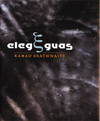Elegguas
The ten sections of Elegguas are structured around a series of “Letters to Zea Mexican.” I needed to know who she was (the first letter begins with her death, seeing her for the last time) and she wasn’t hard to find. A quick search online turned up summaries and reviews of Brathwaite’s Zea Mexican Diary (1993), an award-winning memoir/diary about the death from cancer in 1986 of his wife, whom he called Zea Mexican, an allusion to her ancestry. The first letter in Elegguas, is, in fact, dated 1986, the year of her death. Brathwaite, who is from Barbados where he still makes his home part-time (he spends the rest of his time in New York where he teaches at NYU), is a prolific and highly regarded writer both in the Caribbean and in the United States. I confess, however, and with no small measure of embarrassment, that I was not familiar with his work until Elegguas, and I found it helpful to learn about his earlier writing to contextualize and understand this book.
The ten sections of Elegguas are structured around a series of “Letters to Zea Mexican.” I needed to know who she was (the first letter begins with her death, seeing her for the last time) and she wasn’t hard to find. A quick search online turned up summaries and reviews of Brathwaite’s Zea Mexican Diary (1993), an award-winning memoir/diary about the death from cancer in 1986 of his wife, whom he called Zea Mexican, an allusion to her ancestry. The first letter in Elegguas, is, in fact, dated 1986, the year of her death. Brathwaite, who is from Barbados where he still makes his home part-time (he spends the rest of his time in New York where he teaches at NYU), is a prolific and highly regarded writer both in the Caribbean and in the United States. I confess, however, and with no small measure of embarrassment, that I was not familiar with his work until Elegguas, and I found it helpful to learn about his earlier writing to contextualize and understand this book.
This is a handsome, thoughtfully produced volume, shaped and sized to respect the poems’ requirements for special graphic treatments, page formats, and line lengths, which include changing font types, styles, and sizes; a variety of symbols; narrow, black-line margins bordering the “Letters” text; large drop caps; long, broad lines; irregular spacing; and related visual elements. The design is effective and compelling.
Elegguas (the term, jacket copy informs me, is a combination of “elegies” and “Ellegua,” the Yoruba deity of the threshold) is part-love story, part-family album, part-national history (a series of biographical poems of assassinated political leaders/revolutionaries.) The language varies as much, if not more or more dramatically in many ways, than the graphical treatments, from the intimate and colloquial diction of the work addressed to Zea Mexican, to the lyrical conventions of contemporary western poetry, to neologisms and invented forms, to the grammatical constructs of Caribbean speech. Brathwaite is equally adept and comfortable in all of these idioms, which move fluidly, as does the poet through time and personal and national history as they unfold from letter/poem to poem, between geographies, cultures, and histories.
Brathwaite is a poet capable of great eloquence and elegance (“our wild unaccountable lies”; “solitude a silver thing”); musical precision (“it is that reggae reggae regaae riddim that Xplodes the prison burns the clock”); and inventiveness, as in the style of script he has fashioned that is both the reflection of and the antithesis of the spoken word (“This man proud of you Zea Mexican / as he is from / the very beginning when you first / walk towards me at that dance at NormaForde & KP notice but nvr more so than the day I take you home to RoundHouse and Mile&Quarter & the ancestors evvabody from Mother to Joan & John & all the aunts and uncles & St Elmo i remember”).
I want to be careful not to portray as exotic aspects of Brathwaite’s work that are unfamiliar to me, but which might not be to a reader from his home in Cowpastor, Barbados. Here’s where my online searches failed, me, however. An attempt to decipher the words and phrases I did not recognize in the ninth section, which begins “the writing of the sea did not result / in its escarpment / she said,” proved difficult. “Guernei,” turned out to be a type of sea snail (this made perfect sense, of course); but “thussaluttata” eluded me. I did not, of course, need a dictionary to figure out “unexpected,” but is “TransssaluttatA” part invention or all invention? Perhaps the larger question is do I need to know what has concrete referents and what is pure invention to appreciate the work or to understand most of what I need to about the stories revealed here? And, the answer, happily, is no. In fact, at the risk of making something seem exotic, which, inherently, is not “foreign,” I would say the work does, in some ways, strive to have me ask these very questions.
And, ultimately, who needs a reference manual to understand these poems’ emotional power? Here are the final lines from the book’s conclusion, the last letter to Zea Mexican, subtitled “The Crossing”:
…setting out to find her in that landscape over there so near
so far far away in the grey green going-
>down evening sun forever & forever<
Heartease Which is where she is/in that
soft distance shining & i’m suddently & at
last happy & very very sad & lonely at h
(e) same time because she feelin so lonely
but somehow at peace & there was noth
ing i cd do nothing nothing, i cd do any <
more nothing i cd ever do ever & ever a-
gain but to lose her there & that way wh-
ere i cd see & not see her beyond th-
at valley high up here in the
Blue
Mountains





